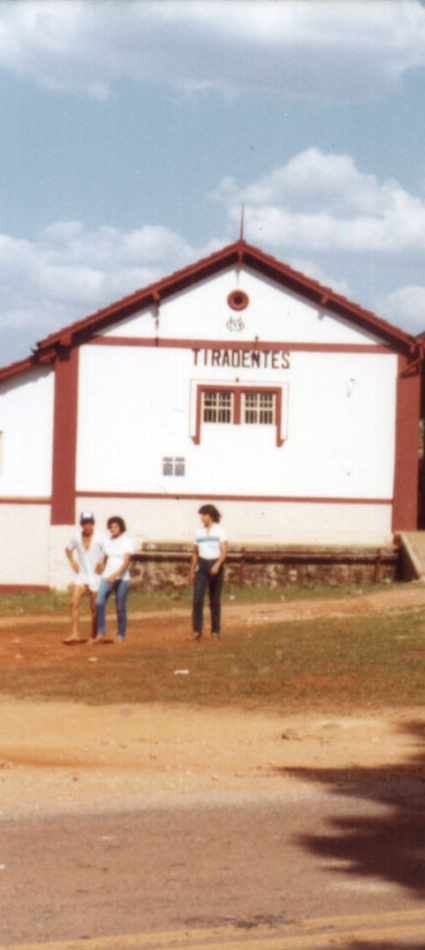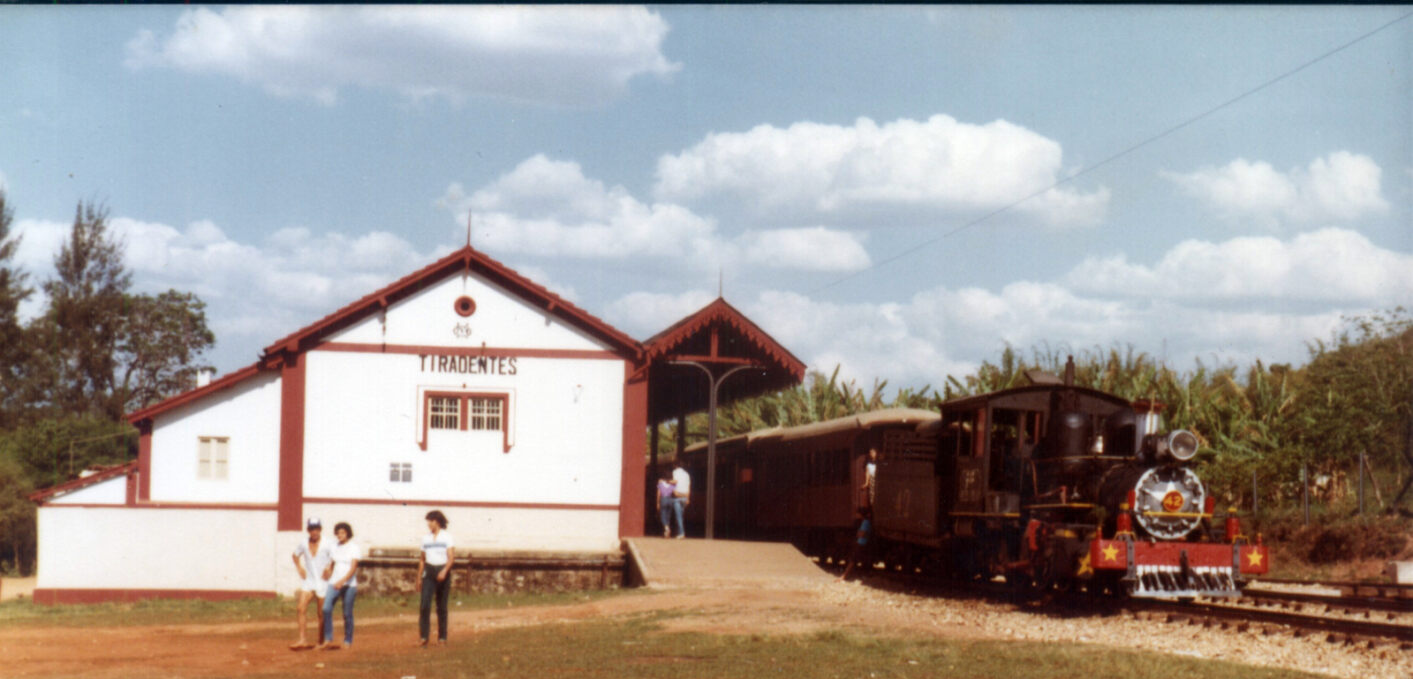A DAY WITH NO CELEBRATION, BUT TO BE CELEBRATED!
The line was to be inaugurated by then emperor Dom Pedro II, and the city of São João del-Rei awaited him with a grand celebration. In Tiradentes, anticipation was enormous, with people dressing in their finest and most elegant attire. However, the Minister of Agriculture, Buarque de Macedo, who was accompanying the emperor on the journey, suddenly fell ill and passed away in São João del-Rei, leading to the cancellation of all festivities. Dom Pedro II inaugurated the railway and visited Tiradentes Station, but in a discreet manner.
And so our history began! After that, the steam train, or “little train” as many affectionately call it, became part of everyday life, work, love stories, families, dreams... people's lives!
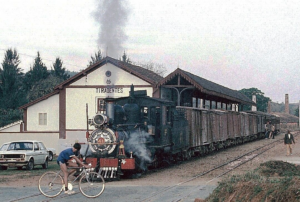
Everyday life at Tiradentes Station. Ramiro Nascimento, 1982. Personal collection.
Ramiro Nascimento -São João Del Rey (11).JPG
Simplicity in form, elegance in detail
At the time of EFOM's inauguration, Tiradentes was a rural town, with little economic relevance to the region. The railway station, therefore, is small, and its architecture is simple. Designed in an eclectic style, it mimics English countryside railway stations, featuring a masonry building for the station's social activities and a covered platform for passenger boarding and disembarking.
Despite the simplicity of its architecture, the station features striking ornamental details, such as the eaves of the platform roof, carefully finished with lambrequins, as well as a garden with influences from classical landscape architecture, featuring orthogonal layouts, bordered flower beds, centered ornamental or native plants, and a concrete fountain in the center.
Tiradentes Railway Station is a protected heritage site, listed by IPHAN in 1989, and is part of the São João del-Rei Railway Complex.
“Tiradentes Station is a rural station, removed from the architectural context of the city's eighteenth-century Historic Center. It is much simpler than São João del-Rei's, simpler than Prados'. It is more akin to Ibituruna's, part of this set of small stations in the countryside."
"The train is in music, in painting, in samba, it's in all artistic expressions! It is very important for architecture. The railway brought eclectic architecture here, and it imposes itself in a very elegant way. We have beautiful eclectic buildings in the region, influenced by railway architecture. It's a very complex, very rich cultural universe!”
Luiz Antonio da Cruz, teacher and researcher, resident of Tiradentes.
“This railway memory deeply moves me because everything was so beautifully designed, with its own architecture, scale, and proportions, all part of a much larger project. Thus, it embodies aesthetics and spatial dimensions that we no longer see today.”
Maria José Boaventura, visual artist, illustrator and author, art teacher and resident of Tiradentes.
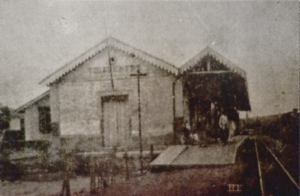
Tiradentes Station seen from the front. Lambrequins adorning the roof of the station can be observed. Author unknown, 1920. Acervo Hugo Caramuru.
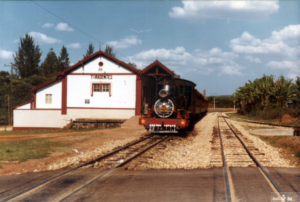
Tiradentes Station and Locomotive 42. Mário Arruda, 1984. Personal collection.
The Architectural Style Introduced by the Railroad
Eclecticism is an architectural style that emerged in the mid-19th century and had a strong influence until the early 20th century. Eclectic architecture is directly related to the railway, as it reflects the spirit of its time: since the Industrial Revolution, with the development of machinery and advances in engineering, new materials such as steel and glass have been incorporated into architectural practice, while cement and ceramics have become more accessible, offering greater versatility in use.
Widespread availability of industrialized materials made new construction techniques possible. For instance, masonry became extensively used in homes, which had traditionally been constructed using vernacular methods like rammed earth and wattle and daub.
Given the novelty of these materials, their application was experimental, gradually being integrated into existing architectural styles such as classical, baroque, and gothic. This resulted in a transitional architectural style, blending traditional characteristics with industrial innovations.
Eclectic-style railway stations played a significant role in making this architectural language more popular. They featured gables facing the street, molded door and window frames, and lambrequins on the eaves, contrasting with the previously dominant colonial architecture.
Flirting at the Station
By around 1957, Tiradentes was supplied with a stable network of electric power, allowing people to frequent public spaces after dusk. This led to the emergence of a new activity at Tiradentes Station: “footing,” an English word meaning “stroll” or “recreational walk.”
The night train left São João del-Rei Station for Barbacena every weekend at about 7:30 PM, making its first stop in Tiradentes. A train from Barbacena would pass through at about the same time. Here, teenagers and young adults from both towns would disembark to walk and flirt with the local girls and boys of Tiradentes, who were already waiting in the gardens and on the platform. Anticipation of the train's arrival was a highlight for the youth. These gatherings, known locally as 'footing,' served as a primary social and recreational activity for adolescents. Romances, marriages, and families often blossomed from these encounters.
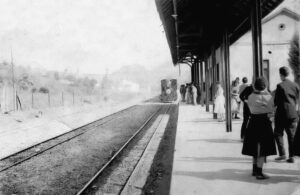
People wait for the train on the platform at the Tiradentes Station.
Author unknown, date unknown. Hugo Caramuru Collection
The Station Through Children's Eyes
The activity and joy that permeated the Station extended to children who used to play there. With boundless energy and imagination, the station transformed into a playground for them. The grass behind the platform could become a soccer field; the platform itself, a long road for toy cars. On the other side of the tracks, near the kaolin depot, a Wild West scene came to life, with railway workers in their elegant uniforms and caps playing the role of heroes.
Adults who experienced these train rides in their childhood hold these memories dear, often recalling them vividly and with great detail. They emphasize the profound impact these journeys had on their lives. Traveling by rail was more than mere transportation; it was a transformative adventure that allowed them to cross unseen city boundaries, discover new landscapes, traverse rivers, and observe diverse human scenes.
Footings occurred all around; everyone came for a stroll in the late afternoon to welcome the train.
Luiz Antonio da Cruz, teacher and researcher, resident of Tiradentes.
“The platform was my city. I often played alone because I liked pulling toy cars. I divided the platform into sections: where my father worked was Tiradentes; the middle was Santa Cruz de Minas; and the end was São João del-Rei.”
Waldonier Trindade Fonseca, public servant from São João del-Rei, and son of the former head of the Tiradentes Railway Station.
“The garden was very beautiful, well-kept, and I played there a lot. Beyond that, there was another lawn along the platform where I played soccer. To me, it was a small soccer field.”
Waldonier Trindade Fonseca, public servant from São João del-Rei, and son of the former head of the Tiradentes Railway Station.
“No Dia das Crianças, as escolas davam uma viagem pras crianças irem no trem. Eu era criança, tinha uns 7 anos. Eu lembro quando fui, ganhamos uma garrafinha de refrigerante, “caçulinhas”, e um pãozinho com salame. Lá, saía um pouquinho do trem, brincava, as professoras contavam histórias.”
Geralda Sueli Guimarães Silva, resident of Tiradentes.
Armadillo with Cabbage x Thrush with Flour
Despite their proximity, São João del-Rei and Tiradentes have each evolved in unique ways, closely intertwined yet distinctly different. The introduction of the railway greatly facilitated the flow of residents and goods between these towns, further strengthening their bond.
A certain rivalry has long existed between the cities, stemming from their early days as villages and evolving over time. In the 19th and 20th centuries, this rivalry shifted from political and territorial disputes of the 18th century to expressions in popular culture and everyday practices.
A tradição oral registra que era comum que os moradores de ambas as cidades, principalmente jovens, colocassem apelidos jocosos em quem vinha da cidade vizinha. “Tatu com Repolho” era como os são-joanenses chamavam os tiradentinos que, por sua vez, os chamavam de “Sabiá com Farinha”. Não se sabe precisar o porquê desses apelidos, mas acredita-se que sejam referências às práticas alimentares locais da época.
“People from São João del-Rei would come to Tiradentes for footing. Then, instead of dating local boys, the girls would often choose those from São João. This caused some discomfort. When the boys were on the train heading back to São João, they would shout at the Tiradentes boys, 'Tatu com Repolho!' and the boys from Tiradentes would yell back, 'Sabiá com Farinha!' One day, the train cars got derailed; the locomotive continued on, but the boys were left behind, leading to a massive brawl! This tale was frequently recounted by Antônio Conceição, who spent his vacations here in Tiradentes. He was known for his many colorful stories.”
Luiz Antonio da Cruz, teacher and researcher, resident of Tiradentes.
A Station That Was Also Home
Tiradentes Station has been part of some families' history for years as it served as their home. EFOM’s Heads of Stations typically lived at the stations with their spouses and children, due to their role in managing the place and overseeing all employees involved in the station's operations.
Families shared their living space with their workplace, fully immersed in the railway environment, just as the place, designed and built for social activities, also served as their home. Rooms now occupied by the Memory Station Exhibit were once intimate domestic spaces, such as bedrooms. In the external garden, these families kept small livestock, fruit trees, and flowers. There are also accounts of wood stoves and laundry tanks being used.
“We lived right in the Station. Back then, the Head of Station lived there with his family because they couldn't just rent a house. There were also houses for the crew, but the Head of Station lived on site. The station was small, but it was home. At the front, there were two bedrooms. My sisters, all eight of them, were in the front rooms, and an older brother in the middle room. I suffered from asthma, so I had to stay close to my mother. I slept in a room next to hers, separated by a screen, and there was a living room.”
Waldonier Trindade Fonseca, public servant from São João del-Rei, and son of the former head of the Tiradentes Railway Station.
“There was a grapevine, lime trees, orange trees, and sugar cane; my mother and sisters took care of them in that back part. Outside there was a wood stove. I liked to stay close to my dad; I enjoyed playing with the telegraph machine, which printed out Morse code. One of my brothers liked to clean the ticket office, polish things for my dad, who was always with us; my mother had many children, and we stayed with him. Even today, if an older person comes to the Station, they ask me if I am the son of João who worked at the Station in the 1970s. People still recognize me.”
Gilberto Luiz Caldas, resident of São João del-Rei and son of a railroad worker.
“Where is Your Belly Button Buried?”
This popular saying, which evokes one’s birthplace, references the ancient practice of burying a newborn’s umbilical cord in the soil. It is believed to bring luck to the child’s life and to anchor their identity firmly to their place of origin
Historically in Tiradentes, it was typical for pregnant women to be assisted by local midwives and deliver their babies at home. As a result, some children of railway workers, like Gilberto Luiz Caldas who was born on June 6, 1975, entered the world within the confines of Tiradentes Station. Gilberto’s umbilical cord was buried by his mother right here beside the mango tree in the station. Over the years, both Gilberto and the tree have flourished together.
This exhibit honors all those born here at the Station or in Tiradentes, whose “navels were buried” here. It celebrates their enduring bond with this place and wishes them continued good fortune.
“That tree, that mango tree... People claim it's centuries old, but it isn't! It grew from the same soil where my umbilical cord was buried when I was born. Burying the umbilical cord was a common practice back then—my mother buried mine. My belly button is literally rooted here at Tiradentes Station.”
Gilberto Luiz Caldas, resident of São João del-Rei and son of a railroad worker.
The Holy Trinity Jubilee: A Major Religious Celebration in Tiradentes
The Holy Trinity Jubilee is one of Tiradentes' largest religious events, celebrated for over 200 years. Held throughout June, the festivities include Masses, processions, and vendor stalls, attracting thousands to the Holy Trinity Sanctuary. This Catholic festival maintains its traditional roots while becoming an integral part of the city’s cultural fabric, regarded primarily as a celebration by and for the people of Tiradentes.
Until the end of the 19th century, the event was relatively modest. However, the establishment of the EFOM railway line in 1881, which improved access to Tiradentes, resulted in a surge of visitors. Special train schedules were even implemented on festival days to accommodate the increased influx.
Devido à sua importância religiosa, social e econômica para Tiradentes e região, em 1962, a Igreja da Santíssima Trindade tornou-se Santuário e, consequentemente, a Festa da Santíssima Trindade passou a ser reconhecida como Jubileu da Santíssima Trindade.
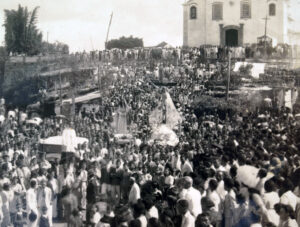
Celebration of the Holy Trinity in Tiradentes, May 1940.
Author unknown, 1940. Tiradentes IPHAN Office Collection.
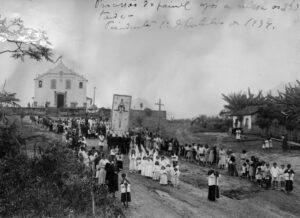
Celebration of the Holy Trinity in Tiradentes, 1939.
Author unknown, 1940. Tiradentes IPHAN Office Collection.
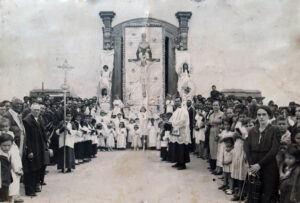
Celebration of the Holy Trinity in Tiradentes, 1940s.
Author unknown, 1940. Tiradentes IPHAN Office Collection.
“I was always amazed because Tiradentes was such a peaceful town back then. Seeing all those people moving back and forth was just astonishing!”
João Rosa da Silva Filho, resident of Tiradentes and former employee of Fábrica Cerâmica Progresso Industrial Ltda (Industrial Progress Ceramics Factory), a prominent ceramics factory in the region.
“We would hike to the hills. My mother, along with her twelve children, climbed the mountain to attend the Holy Trinity Festival. The path led us up the mountain; then we'd descend, walk through the valley, pass by the waterfall, and finally reach Tiradentes—all on foot. We carried our own food—”farofa”, chicken, and large pots of homemade dishes. There were no restaurants, just spots under the trees where we would sit in the meadows, not many houses in sight. We'd spend the whole day, picnicking and relaxing, and walk back at dusk.”
Maria Trindade Rezende Souza, a resident of the César de Pina neighborhood.
“We'd pay for the round trip by train in advance. But when we tried to return from the Holy Trinity Festival, there were no seats left. The train would arrive and fill up instantly; we'd be left standing outside. Once, we missed the last train at midnight and had to sleep at our aunt's house near the old jail. The clever ones got on the train; some even jumped through the windows. With a small child, my eldest son, how could I force our way through the crowd? Midnight was the last train, no more trains after that. If you missed it, you had to spend the night in Tiradentes.”
Biatriz Dias Bastos Guimarães, resident of Tiradentes.
“People continuously arrived every hour, moving through the square, endlessly going up and down. The stalls started in the square and extended all the way to the top.”
João Rosa da Silva Filho, resident of Tiradentes and former employee of Fábrica Cerâmica Progresso Industrial Ltda (Industrial Progress Ceramics Factory), a prominent ceramics factory in the region.
On the festival's Sunday, trains arrived every hour, surprising locals with the sheer number of people disembarking at the station. Visitors from other cities recalled how crowded the carriages were, often requiring them to stay overnight in Tiradentes.
Antes das cinco da manhã, as romarias com famílias e grupos de fiéis chegavam para assistir à primeira missa. Longas filas se formavam para beijar a imagem da Santíssima Trindade e pedir bênçãos. Mais tarde, a procissão que carregava a imagem do Pai Eterno, Divino Espírito Santo e Jesus seguia com milhares de pessoas até a Praça Central.
Along this route, stalls scattered about sold a variety of items, from crafts to sweets, pastries, and fruits, particularly tangerines. Introduced to the region by Italian immigrants, these tangerines, ripe in June, became a symbol of the celebration. The locals of Tiradentes humorously say that the Jubilee is the festival of “PRM”: Prayer, Dust, and Tangerines. This acronym refers to the religious festivities, the dust stirred up by the bustling crowds on the dirt roads, and the widely sold and consumed tangerines.
Daily Life in Times Past
Around 8:30 AM, as the train from São João del-Rei made its presence known with a loud whistle and appeared around the bend approaching Tiradentes, locals were already gathered on the platform in anticipation. A woman carried a basket woven from straw, filled with sweets such as peanut brittle, raw brown sugar blocks, and peanut cookies. Nearby, a man had a basket of artisanal cheeses, while a young man held several bags of fruit; another displayed fine samples of fabric. All these goods were destined for sale in Barroso, Antônio Carlos, or Barbacena. Parents held their children's hands, who watched excitedly as the engine drew closer.
As the train halted, everyone boarded the carriages. The wealthier passengers settled into first class with its plush, cushioned seats, whereas those less financially equipped headed to second class, with its less comfortable wooden benches. From São João del-Rei, several people and boxes of ordered food were unloaded.
A gentleman went to the window of the Postal car to buy a newspaper with news from Rio de Janeiro; he wanted to check the score of the Flamengo game. From inside the train, its driver waved to a group of young people who were there to watch the train pass by, and then he departed, taking each of those individuals to their destinations. A few minutes later, the train from Barbacena stopped at the same place.
Scenes like these were repeated during the weekdays at Tiradentes Station. Schedules for daytime trains were approximately at 8:30 AM, 10:30 AM, 1:30 PM, and 5:30 PM. The last train, known as the night train, passed here around 8:30 PM. After it, everyone would return to their homes, and the Station Agent would turn off the lanterns. Everything would be dark except for a bonfire, sometimes lit by Romani people, other times by Army soldiers camping around the station—and by the moon that illuminated the sky.
The next day, the routine would start all over again. The railway operated with organization and discipline. In the small town of Tiradentes, the train dictated the rhythm of people's routines, and life revolved around the station.
“One thing I really loved was that from Tiradentes Station, we could see the sky. That's when I fell in love with the moon. When we came to the Station at night, it was dark, but it was cool as I loved watching the moon, especially when it was a full moon. It was a spectacle!”
Waldonier Trindade Fonseca, public servant from São João del-Rei, and son of the former head of the Tiradentes Railway Station.
“We had a lot of contact with the Romani people who set up their camp near the Station. They made bonfires, played guitars, and we played with them.”
Gilberto Luiz Caldas, resident of São João del-Rei and son of a railroad worker.
“People sold sweets, cheese, raw sugar blocks, and honey in bottles, all carried in baskets. Passengers would buy these items directly from their seats inside the train. At that time, everyone commonly carried a basket. We always had ours with us, filling them with fruit picked from the trees.”
Gilberto Luiz Caldas, resident of São João del-Rei and son of a railroad worker.
“In those days, life centered around the Station, fostering a sense of community where everyone supported each other like family. This close-knit environment created lasting friendships. Such camaraderie is rare in big cities. Tiradentes felt like a small village where you could visit anyone at any time. The Station was a hub of social interaction, connecting us all.”
Gilberto Luiz Caldas, resident of São João del-Rei and son of a railroad worker.
“Eu fiz faculdade de 1964 a 1967. O trem passava de manhã para São João del-Rei e voltava de noite para Antônio Carlos, perto de Barbacena. Chamava Sítio. Eu viajei por quatro anos nele à noite, às 19 horas. As aulas da faculdade eram durante o dia. Se eu viesse de ônibus, eu perdia metade da última aula. Então eu vinha de trem: ele saía 19hs de São João del-Rei, chegava aqui em Tiradentes, às vezes, 21hs, 21:30hs porque parava na Casa da Pedra para carregar e descarregar.”
Vitória Gomes, retired, resident of Tiradentes.
For the young people of Tiradentes, the train was more than just transport—it was an adventure. On Sundays, when there wasn’t much else to do, we would gather at the station to watch the train pass by at night. We watched it arrive, milled around, and then walked home as it departed. I was 16 or 17 years old back then; today, I am 83.
Maria Lúcia Gomes Paolucci, retired, resident of Tiradentes.
“We could recognize them by sound alone; often, we didn’t even know which train was approaching. But we listened for the noise—the distinct whistle—and we could tell which locomotive it was and whether the usual train driver was at the helm. The train's whistle gave away who was driving. This familiarity developed from hearing it every day.”
Sergey Portes, retired, grandson of a railroad worker, resident of São João del-Rei.






